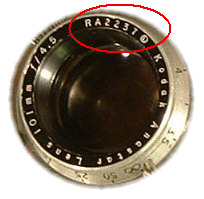 |
||||||
|
|
||||||
|
Kodak Serial Numbers. Making a definitive statement about serial numbers over the course of Kodak history is difficult. Most print histories of Kodak and most collectors' Web sites omit this information. My experience collecting Kodak models manufactured from the late 1930s to the 1960s is the basis for the comments that follow. Only the most expensive Kodak models included body serial numbers. Of domestic fixed lens cameras I think only the Medalists included numbers stamped on the film gate. Ektra bodies had serial numbers that matched numbers stamped on the interchangeable film backs manufactured with the bodies, because of the close tolerances required. Many of the cameras manufactured in the Nagelwerke factory, including early Retinas, had serial numbers stamped on the film gate. Kodak mounted lenses from several manufacturers through the late '30s. Presumably some had their own numbering scheme and others may have accommodated Kodak's wishes in numbering. Early upscale Kodak models had numbered lenses, though I have not seen information about the numbering scheme and my personal collection of 1930s models is not large enough to even hazard a guess about how numbering was structured. My early Anastigmat Ektars have five digit serial numbers. About
1940, Kodak began creating alphanumeric serial numbers for most of its
better lenses--Ektars and Anastigmat Specials (later Anastars) that identified
the year of manufacture. This was in the general form 'LLNNN', where the
first two letters identified the year and the numbers were the serial
number. The
|
||||||
 |
.
 This lens was made in 1952. |
|||||
| Here is a quick reference table using the U. S. pneumonic: | ||||||
| EY
= 1940 EC = 1941 EA = 1942 EM = 1943 EE = 1944 ER = 1945 EO = 1946 ES = 1947 EI = 1948 ET = 1949 |
RY
= 1950
RC = 1951 RA = 1952 RM = 1953 RE = 1954 RR = 1955 RO = 1956 RS = 1957 RI = 1958 RT = 1959 |
OY
= 1960 OC = 1961 OA = 1962 OM = 1963 OE = 1964 OR = 1965 OO = 1966 OS = 1967 OI = 1968 OT = 1969 |
||||
| Most serial numbers are stamped on the ring that secures the front lens group and identifies the lens type, length and maximum aperture. The serial numbers for Ektra Ektars are stamped on that part of the the lens barrel that fits into the camera mount.
|
||||||
| How were
the serial numbers assigned? Sequential by year or sequential by lens
model? Given the relatively high serial numbers of some lenses, and that
Kodak probably wanted a unique number on each lens, it appears to me that
a single annual sequence was used. To have assigned numbers by model,
would have produced many duplicate numbers and made public use of these
as identifying numbers very confusing. If lens rings were produced in
a single shop, they likely would have been produced in batches. Perhaps,
if the shop were going to make 50 rings for 80mm WF Ektars, they took
the last number used and started their run from that point. If production
were more dispersed or done in parallel operations, perhaps they assigned
ranges of numbers based on projected production. In the page tracking
1940s serial numbers If you are interested in when Kodak began coating its lenses, I have a small project to collect data based on manufacturing date. |
||||||
 10/27/2010 11:57 |
| |||||